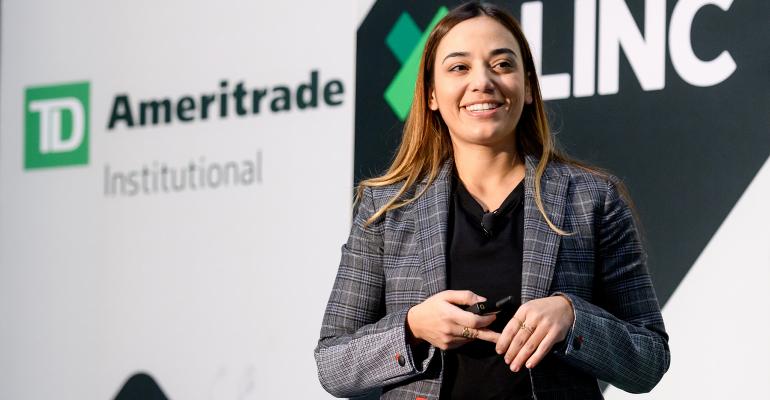Virtual assistants and voicebots are moving from consumer technology into advisors’ practices and tech stack, with TD Ameritrade Institutional introducing a pair of Alexa skills, one for end-clients and another for advisors, and a virtual assistant integrated with Veo One.
But the additions, including one that will make it easier for clients to check their balances, raise concerns about the role of automation, accessibility and how secure the new methods of communication will be. The virtual assistant is currently in beta, while the Alexa skills complement a flash briefing—short, informative pieces of prerecorded audio—already available for individual investors.
The virtual assistant is a way for TD Ameritrade Institutional to gather data about advisors, while providing value and convenience. The tool both answers inquiries and learns new answers, said Jon Patullo, managing director of institutional technology solutions at TD Ameritrade Institutional.
For instance, An advisor might use the virtual assistant when inquiring about opening a new account at the firm. Such a simple request for information can be handled by the virtual assistant, but if the problem is too complex, a human operator will take over.
The virtual assistant doesn’t stop operating, however. Learning from the human response to the complex inquiry, the virtual assistant develops a new data point and adds to its repertoire of responses, Patullo said. In that manner, automation is able to creep into the process. “It sort of gets smarter and smarter over time,” he said. The advisor gets an answer to a question, while the firm is able to fine-tune its algorithmic responses and gather insight into common friction points.
Meanwhile, the Alexa skills give advisors TD Ameritrade Institutional flash briefings, while end-clients are able to use a separate skill to inquire about balances, positions, quotes and market activity. It’s all part of a push to use technology to augment advisors, said Dani Fava, director of institutional product strategy and development at TD Ameritrade Institutional.
But some are worried the firm isn’t striking the right balance between giving access to information and supporting advisors trying to promote responsible financial behavior in clients.
“You don’t want people looking at an account balance every day,” said Kevin Norris, president of Girard, Univest Financial’s wealth division. Constant balance-checking during periods of market volatility can be unnerving for clients and lead to risky financial behavior, he explained. “The longer doubt creeps into clients’ minds, the harder it is to correct.”
In that way, accessibility is a double-edged sword. Norris’ concern wasn’t end-clients having better access to account balances, but that advisors didn’t have the same rapid means of communicating with clients. Plus, advisors don't know when a client is checking an account balance. If an advisor senses something is wrong with a client, or is even just trying to be proactive, there are only so many communications options available. “We can send an email, but it’s not a guarantee it will be opened,” he noted.
The imbalance of clients having easier access to their account data, while advisors lack correspondingly easier access to their clients, shouldn’t keep advisors up at night, said Patullo. “A client that’s managing their own account will probably be the one logging in 12 times,” he said. “We have mobile apps and all different ways that a client is looking at that client account.”
For clients with advisors, the end-client may check a balance, but they’ve turned the handling of their money over to a professional and advisors have to trust that relationship, he added. “The advisor’s managing all that risk for the client, so they don’t have to worry about that panic.”
Alexa skills as a method of accessing client information brings up security concerns, too. Clients who enable the skill will need to establish a verbal passcode, analogous to a verbal ATM PIN. The voicebot will request that information in order to enter the client’s account. Of course the passcode has many of the same strengths and weaknesses of a PIN: lose or forget it, or have it overheard by someone else, and the account could be accessible to someone who shouldn’t have access.
TD Ameritrade Institutional views the Alexa device as an internet service provider, essentially categorizing it with web browsers. TDAI is responsible for security after the user enters credentials, said Bryan Baas, managing director of institutional oversight and controls at the firm. Regulators haven’t provided clear guidelines on new technology, he added, so companies looking to new methods of interacting with clients, such as voice technology, need to apply their own due diligence.
The firm is proud of its new technology and has invested resources in its scalability and security. The voicebot functions currently available with Alexa-enabled devices can be extended to Google Home and other devices if they’re deemed a success, said Fava. The virtual assistant is scalable and can be implemented in a client-facing manner, added Patullo. TD Ameritrade already has customer interaction capabilities on a variety of messaging platforms, such as Facebook Messenger.
While concerns about accessibility and security may exist among advisors, one thing they shouldn’t worry about is their importance to TD Ameritrade Institutional. New technology, including advancements like artificial intelligence, is there to help advisors, said Fava. “The RIA profession is going to be one of the last on earth to be replaced by machines.”




